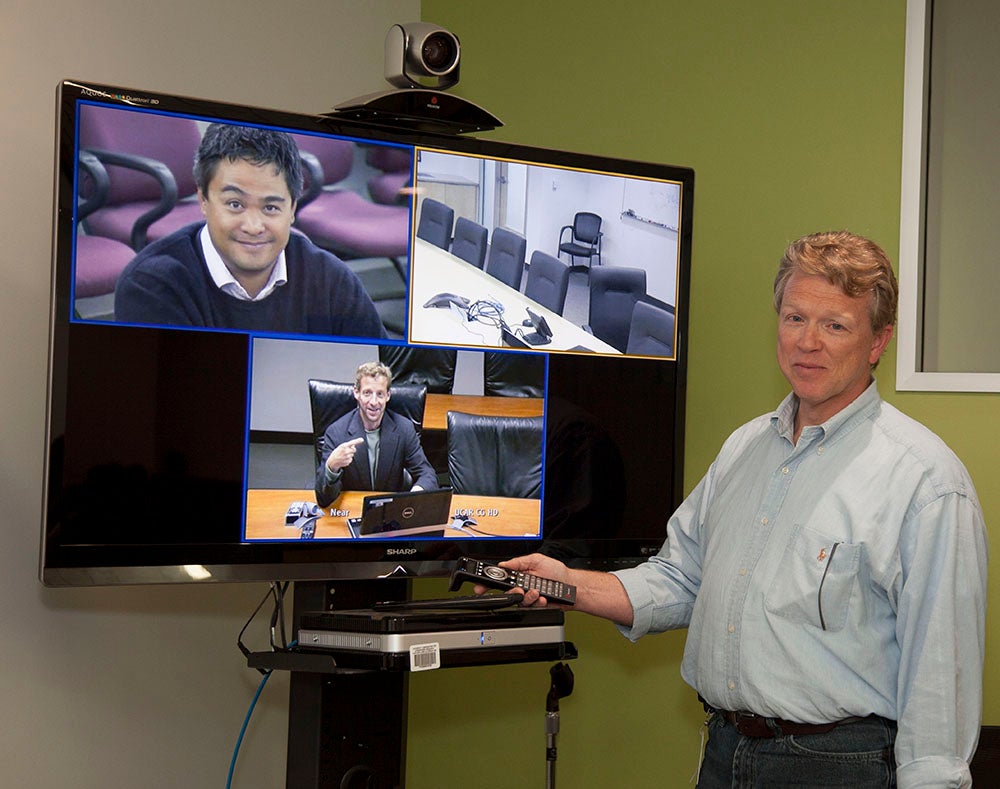Cyber-conferencing comes of age
Multiple technologies open new doors
Dec 3, 2012 - by Staff
Dec 3, 2012 - by Staff
December 3, 2012 | With staff members spread across nearly a dozen buildings in the Boulder area—not to mention the new NWSC in Wyoming, the Mauna Loa Solar Observatory in Hawaii, and other locations—NCAR and UCAR are calling more often than ever on virtual modes of meeting. Options for sharing audio and video to convey content from multiple sites have grown substantially over the last few months, thanks to new software and hardware.

Jeff Van Damme (right), who heads up UCAR Multimedia Services, demonstrates the power of high-definition, screen-within-screen conferencing. (©UCAR, Photo by Carlye Calvin.)
There’s also a new person overseeing this technological evolution. Jeff Van Damme took the post of head of Multimedia Services in August in the wake of Eron Brennan’s retirement. “Eron left a great group and a fantastic legacy,” says Jeff.
Jeff’s team is orchestrating an increasingly varied set of capabilities, working to upgrade systems in line with budgets and priorities. Not every group at UCAR has the same multimedia needs, Jeff points out, but many of the current facilities are available for anyone to use, and Multimedia Services is happy to work with groups to identify what tools might be helpful.
Here’s a quick guide to the main conferencing options now available:
One of UCAR’s first rooms equipped for high-definition video conferencing is FLA 2111, recently outfitted with an array of microphones, HD cameras, and an HD-capable codec. The UCAR President’s Office, housed upstairs, expects to use the room for meetings with NSF and other stakeholders. It’s also available to any group by requesting a reservation through MeetingMaker and the Room Reservation System. Jeff’s office keeps an eye on the reservations to ensure that the capabilities at the remote sites mesh with our own systems. “This gives us a chance to check protocols with all participants,” says Jeff. “There are a lot of legacy systems out there, and we need to be prepared for that before the client walks into the room.”
Given that many people are taking care of business from a tablet or smartphone as well as a desktop, yet another mode of conferencing is on the rise. Multimedia Services is actively testing a desktop videoconferencing application called Vidyo that enables people to jump into a meeting from wherever they happen to be. In one recent example, Multimedia Services succeeded in bringing two remote participants into a meeting in the CG auditorium. Thanks to Vidyo, a doctoral student at a coffee shop on the University of Missouri campus in Columbia and a geosciences professor in her office at the University of Massachusetts Amherst were able to join in.
CISL has made extensive use of Vidyo over the past year to manage and monitor progress at the NWSC. In addition to the primary use case of Vidyo on a variety of client platforms, two “VidyoRoom” systems in CISL (ML 34 and 40) have allowed CISL staff in Boulder to bring in remote participants from NWSC and elsewhere. Another example of Vidyo use is by staff at NWSC who have used cameras mounted on iPads to walk through the NWSC’s vast computing room, giving CISL staff in Boulder a view of the Yellowstone supercomputer elements as they were being installed.
“You can use the camera on the front to show your face and participate in a meeting, or you can switch to the camera on the back to show a machine to a remote engineer,” notes CISL’s Jeff Custard, who’s monitored and documented his lab’s Vidyo experience over the last year. The initiative was prompted by the NWSC’s creation, as well as a multidivisional survey done by the Collaborative Technology Advisory Group exploring technologies that might be worth acquiring for the institution as a whole. Collaborators in the Vidyo testbed include CISL’s NWSC staff, the lab’s Network Engineering and Technology Section, and UCAR F&A. There’s project background at a wiki.ucar.edu folder maintained by Jeff Custard.
Multimedia Services will examine the CISL/NWSC experience as it considers how and when Vidyo might be expanded to other parts of the institution, which would require a broader site license and other steps. “Vidyo is a very capable tool that fit the NWSC circumstances very well,” notes Jeff Van Damme.
If you have questions related to videoconferencing options for your particular needs, contact Jeff (ext. 1123).